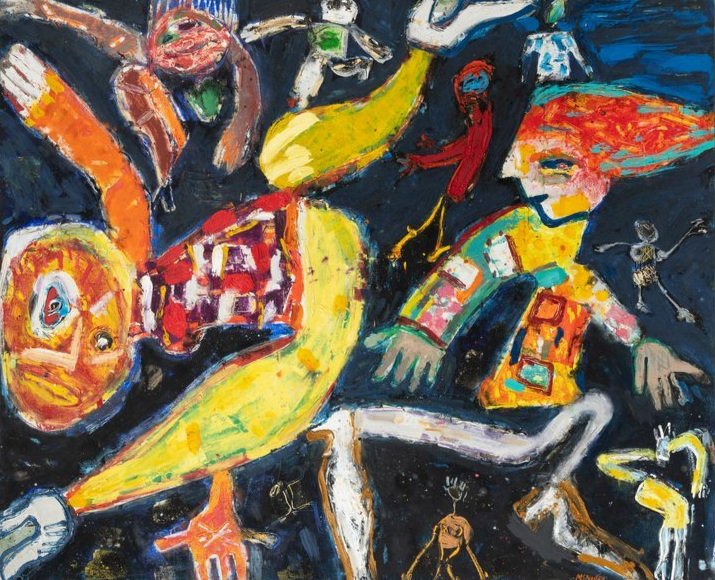Resources
ABOUT US / SERVICES / OUR CLIENTS / STORE / CONTACT
Review (via The SUN, NY): George McNeil, an Underappreciated Hometown Boy, Highlight a Healthy Gallery Season
by Mario Naves
via The Sun, NY
‘Estate of George McNeil: Discos and Dancers’
Picture Theory, 548 W. 28th St., Suite 238
Until May 11
Here’s a question that passed through my mind as I visited Picture Theory, a newish exhibition space at Chelsea: Would George McNeil (1908-95) have stooped to posting his paintings and prints on Instagram? I say “stooped” because of the animus McNeil had for self-promotion. This was the man who bowed out of Nina Leen’s renowned portrait of The New York School, “The Irascibles,” a photo that did much to cement its primacy in the public eye.
Think about it: The Mount Rushmore of Abstract Expressionism — Jackson Pollock, Willem de Kooning, Mark Rothko, and … George McNeil? There are myriad reasons an artist’s reputation does or doesn’t scale the heights. Personality is one of them; cultural cache is another. McNeil bristled when his individuality was put under duress: no team player, he. Still, McNeil’s peers held the work in high esteem — de Kooning was a fan — and scratched their collective head at his lack of notoriety.
McNeil’s art found an audience in the mid-1980s. His late canvases — rambunctious meldings of AbEx facture and graffiti-influenced pictograms — benefited from a renewed interest in both Expressionism and figurative painting. Given the buoyant and often uproarious nature of the compositions, not a few observers thought McNeil had finally achieved maturity at the ripe old age of 70-something. “As George McNeil gets older,” a former New York Times critic, Michael Brenson, wrote, “his work gets younger.”
“Discos and Dancers,” the current exhibition of McNeil’s art at Picture Theory, puts that theory to test. Among the most striking paintings in the show, “Occasion” (1966), predates McNeil’s popular heyday by a good two decades. Its melding of ArtBrut imagery with a Bonnard-like color palette may have been fobbed off at the time as not being sufficiently innovative. Yet McNeil was less interested in the outre than in the primal. He was painting for the long game. That, and the overriding subject of his work is joy. In the end, maybe McNeil wasn’t irascible enough.
McNeil’s pictures have not gone unnoticed by our cultural institutions. The work is included in the collections of MoMA, the Met, and the Whitney — where, for the most part, it has been gathering dust in the storage racks. You’d think our hometown institutions would want to celebrate a hometown boy, particularly given how much the paintings were inspired by our local music scene. Punks, disco dollies, and headbangers, oh my.
"Discos and Dancers" at Picture Theory, NYC (Mar 15-May 11)
Demonic Disco, 1984
Picture Theory presents “Discos and Dancers” from the Estate of George McNeil
March 15–May 11, 2024
Opening Reception March 14, 6–8PM
Picture Theory
548 W 28th Street, Suite 238
New York, NY
“As George McNeil gets older, his work gets younger,” observed critic Michael Brenson upon seeing the 80-year-old artist’s latest work (1). Inspired by his love of movement in Balanchine and Afro-Cuban dance, the rise of MTV, and the beats of John Coltrane, the Supremes, and Tina Turner filling his studio, McNeil embarked on the most exuberant and youthful series of paintings of his career throughout the 1980s until his passing in 1995. For example, his “Disco Series,” begun in 1981, captures the raucous, rapturous energy of New York nightlife. Weightless, colorful figures float across boundless, groundless space. The push and pull of color finds analog in the oppositional tension of limbs askew, torsos off kilter, and heads inverted, evoking the transcendent euphoria of the dancefloor.
With titles like Demonic Disco, the series conjures the conspiratorial relationship between music and dance to possess all senses of the body. The dynamic, sinuous lines, acidic colors, and surging brushstrokes strive for what the artist called, “pictorial sensateness,” or sensation experienced in form. Yet in these paintings, an ambiguity and disquiet pulses beneath the manic exhilaration, fantasy, and sexuality. Disco is, after all, a solitary dance, in that bodies move alone without touching other bodies. In these crowded disco canvases, figures may overlap, but they never seem to actually touch. A self-described humanist, McNeil lends pathos to the mythological, sometimes tragic, often sensual, Dionysian tales of the New York night.
The 1980s saw the Abstract Expressionist painter fully reveal the figure that had been lurking beneath his vibrant and spontaneous impastoed abstractions in decades prior. Dancers, bathers, and other human forms began emerging from fields of color in the 1960s. By the 1980s, McNeil had introduced bold, colorful outlines to sharpen their distinction from their painterly surroundings. The figures also became less universal and more specific, referencing punk rockers, football players, or the urban types encountered on Park Place and 47th Street.
For McNeil, these later bodies of work did not mark a significant break from his early abstract compositions. In an interview, he mused that “it seems to me that my work has always had not a human figure image, but it always had a figural image. ...I’m not a figure painter at all. I’m an abstract painter where I hope that bringing in the figure brings in certain human or psychological connotations or associations, and I hope that deepens the meaning of the picture.”(2) Expressionism, above all else, is paramount.
McNeil enjoyed a late career renaissance as critics found affinities in these paintings with German Expressionism, COBRA, Jean Dubuffet’s art brut, and more contemporary developments in Neo-Expressionism and graffiti art. Yet, McNeil’s “figural images” exude a personal, empathetic, and passionate warmth unique to an artist dedicated to articulating the complexities of our inner and outer worlds. His forceful compositional choices, singular color palette, and virtuosic application of paint evidence an artist passionately driven by the endless pursuit of plastic expression.
- Kara Carmack, March 2024
For more information, please visit picturetheoryprojects.com




